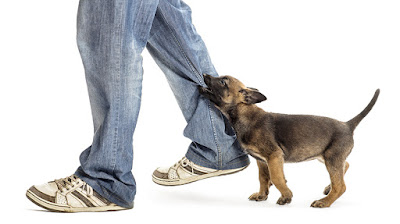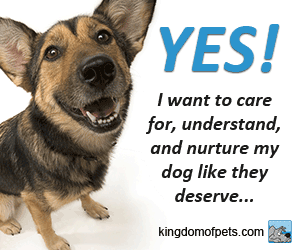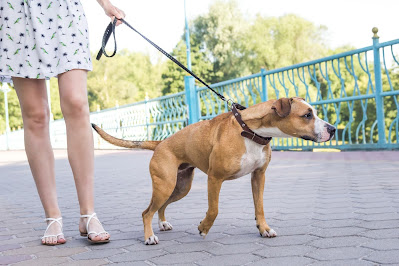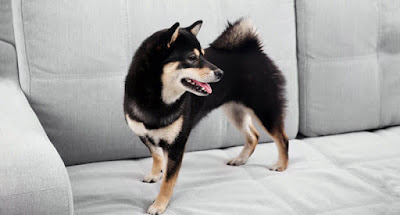Nipping and play biting
Nipping is very different from true aggression: it's a form of communication, interaction, exploration, and play. From birth, pups use their mouths to explore the den, their mother, and their littermates. From a few weeks old, they use their mouths to play with their siblings: puppies play by biting and mouthing each other. Some adult dogs - usually, those with owners who encourage rough play, or who were removed from the litter at too early an age - retain these same tendencies to nip during play and in moments of emotional duress.
Sibling play is actually how young pups learn a very important lesson, called bite inhibition. If a puppy bites another puppy too hard, the other pup yelps loudly in pain and stops playing with him. This teaches the biter that such a degree of bite force results in an undesirable outcome: social isolation. When other puppies bite him, that's how he learns what that pain feels like. (This is one of the reasons that puppies removed from the litter too early are often 'maladjusted' - they've missed out on some of the important lessons their mother and littermates have to teach).
Even pups that have learned basic bite inhibition from their siblings usually need to be reconditioned again upon entering their new home: humans are much more easily damaged than dogs, so it's necessary for us to intervene and refine the puppy's bite pressure even further. A dog without any concept of bite inhibition is both annoying and dangerous to have around: a harmless play session can rapidly turn into painful ordeal.
Puppies aren't capable of inflicting serious damage - although their little teeth are razor sharp, their jaws are too weak to do much more than elicit a trickle of blood - but an adult dog can do a great deal more than just scratch the surface, and it makes very little difference to a wounded human that the dog "didn't mean to do it"!
Here's what to do to teach your dog good bite inhibition
Note: this same technique is applicable to older dogs, although the same results may take a little longer to attain.
- When playing with your puppy or dog, you'll need to choose the level of mouthing that you're prepared to accept. Some owners are content for their dogs to touch their hands with their teeth, as long as no pressure is exerted; others (particularly those with large, strong-jawed dogs) prefer to get the message across that no tooth-contact is acceptable whatsoever.
- Whenever you reach your level of tolerance with your pup - he might give you a good nip, or he might just grab your fingers gently in his mouth - squeal shrilly and loudly in pain and immediately turn your entire body away from him. Get up and walk a few paces away from him, keeping your face and eyes averted. Don't speak to him, and don't touch him. The aim here is for the puppy to be completely socially isolated for the next 20 to 30 seconds - long enough for the lesson to sink in, but not long enough for him to forget what it was that elicited such a response and start playing with something else. (Note: if there are other people present, you'll need to ensure that they mimic your behavior here - don't allow them to start playing with or otherwise paying attention to the puppy or dog, or else all your good work will have been undone).
- Most young dogs, and some older ones, seem to have an innate need to chew something - anything! - whenever they're being played with or petted. To keep the focus off your hands, and prevent him from learning what a delightful chew toy your fingers make, supply him with a more appropriate chew: anything with a slight give to it should do the trick. Rawhide bones, pigs' ears, or squeezy rubber toys all go down a treat.
- If he should start snapping for your hands or face while playing, correct him quickly with a sharp, "No!", or "AH-ah-aaah!" He should stop, startled. As soon as he stops, praise him (you're praising the stopping, not the original behavior - don't be confused by their close proximity) and then quickly redirect his attention to an appropriate chew. When his jaws close around it, praise him again and give him a pat.
- Never use physical force to correct your dog for inappropriate chewing or mouthing. Not only is it mostly unnecessary, but in most cases it will actually encourage further nipping and biting. The cold-shoulder technique (as outlined above) is the most effective, and humane, manner of conveying your displeasure to your dog. He wants to please you: he just has to figure out how to do so. He has a much better chance of doing so if you refrain from corporal punishment and give him 30 seconds of isolation instead.
- If your dog's getting really revved up and is making repeated attempts to nip you, despite cold-shouldering him, he might need to cool down a bit. In this case, the 'time out' method is appropriate: take him to his crate, or to a small room by himself, and leave him there for five minutes to chill out a bit. When it's time to bring him back into the heart of the household, you can start playing again - just try to tone it down a notch or two until you're sure he can tolerate the play without further nipping.
- For a dog that needs little encouragement to become overexcited and mouthy (high-energy herding breeds in particular are prone to this), choose non-contact play whenever feasible. Frisbee and fetch are great choices; even tug-of-war, provided your dog knows a reliable 'drop it' command, is suitable. Avoid rough play like slap-boxing (where you hit the sides of a dog's face gently with open palms) and full-on wrestling at all costs: these games encourage nipping, but also call a dog's instinctive aggression into the mix, which is something to be avoided. Keep games friendly and low-key instead.
For more information
For further information on typical doggie behavior, including a fantastic resource for training how-to's and loads of detailed information on preventing and dealing with problem behaviors, check out Secrets to Dog Training. Written by a professional dog-trainer, it's an absorbing guide that deals with all the subjects a responsible dog-owner could ever want to know about - well worth a look. To visit Secrets to Dog Training, just click on the link below:





